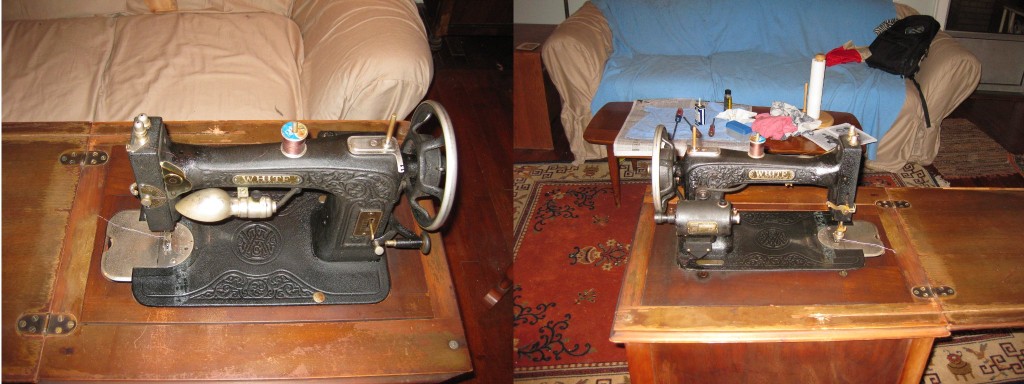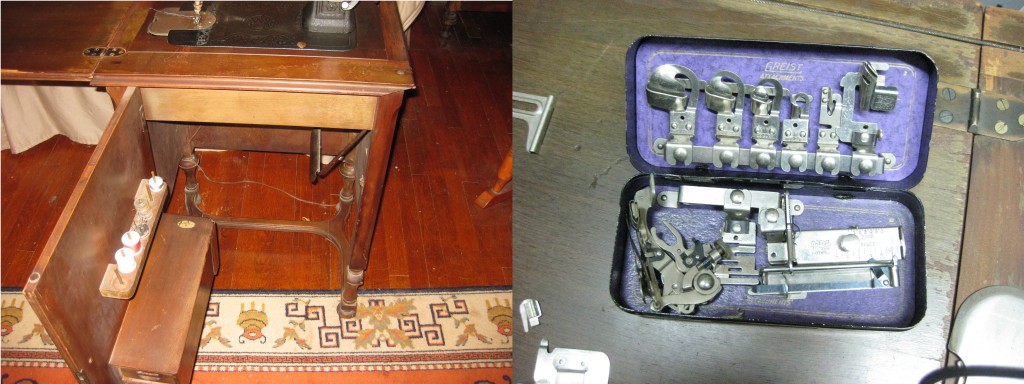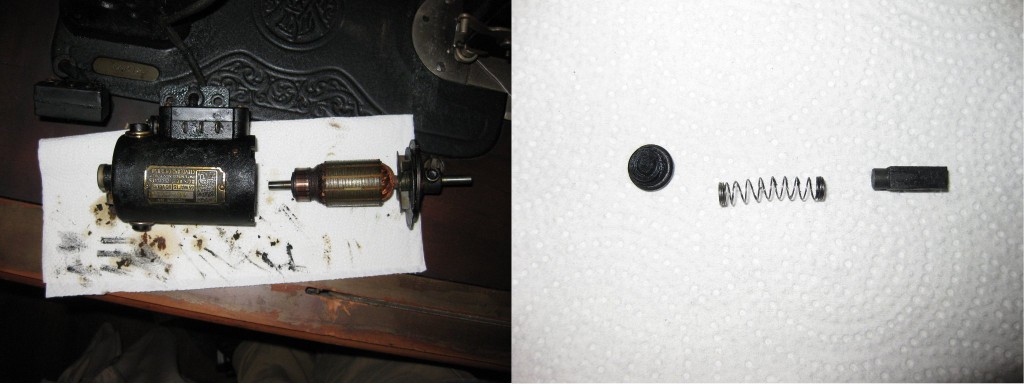My parents were travelling over UK’s spring break, and I was watching their cats. This meant I had some idle time waiting for the indoor/outdoor to do whatever it is he does outside, and generally keeping the cats company in their house, so I wanted a project to play with there.
What I settled on was poking at the old sewing machine my mother had in the attic, because old sewing machines are cool in every way.

I knew from talking about it that it was a White, was very old, and was a straight stitch machine. I pulled the head (~30Lbs) out of its cabinet, and carried the two pieces down to poke at them.
A little bit of internet-foo identified the machine as a White Family Rotary – specifically, it is the sort with cast-in (embossed) decoration on the body, a factory original motor, and a crinkle finish. Establishing historical details on Whites is harder and less precise than with some of the other old manufacturers (especially Singers), as the available records are not as complete, and the machines were less distinctly marked. My best guess from reading the available resources and comparing against the machine is that it was built not long
Cosmetically, it has some surface rust which would would likely be mildly destructive to buff out on the chromed (nickeled?) parts, and some minor finish damage on the bed under the dried-in masking tape I soaked off with some mild(…ish) solvents. While the crinkle finish and embossed detail are unusual and attractive, they are seriously difficult to clean, and there is still some residue from the generations of tape in the texturing. If going about fully restoring it, most of the bare metal parts would probably need a bath in a non-polar solvent (hello kerosene) or ultrasonic cleaner full of degreaser, followed by electrolytic or catalytic rust removal for the parts above the bed, but a quick rub with an oily rag cleaned them up pretty well and should keep them nicely preserved for some years yet.
 The cabinet is nifty in it’s own right (neat historical note: the White Sewing Machine Company actually owned their own forests for the production of sewing cabinetry) with a knee control, a folding leaf/cover, and a steel cable/pulley rig that automatically lifts the machine with mechanical assistance when the leaf is opened. It is, however, fairly beaten up. There is also a full set of original
The cabinet is nifty in it’s own right (neat historical note: the White Sewing Machine Company actually owned their own forests for the production of sewing cabinetry) with a knee control, a folding leaf/cover, and a steel cable/pulley rig that automatically lifts the machine with mechanical assistance when the leaf is opened. It is, however, fairly beaten up. There is also a full set of original
 The only issue with the machine is electrical – my mother had mentioned the motor sparked before it was put up, and the behavior repeated when I plugged it in and applied power. Like most machines of that era, the insulation on the portions of the wiring which hadn’t been replaced is …disturbing… but in this case appears to be reasonably safe – it would probably need to be replaced for regular use, but since the machine has standard, easy to follow wiring on enclosed screw terminals that would not be a big deal. The actual sparking issue was so obvious I almost missed it: all old style sewing machines use universal motors, which have a pair of spring-loaded conductive brushes connecting the armature to the body. This machine only had a spring on the lower brush, and the sparking came from gunk on the armature pushing the upper brush momentarily out of contact, creating a series of arcs (which in turn burnt up some of the gunk). Replacement springs should be easy to find at a hardware store, or specific ones could be purchased as motor brush kits for similar motors.
The only issue with the machine is electrical – my mother had mentioned the motor sparked before it was put up, and the behavior repeated when I plugged it in and applied power. Like most machines of that era, the insulation on the portions of the wiring which hadn’t been replaced is …disturbing… but in this case appears to be reasonably safe – it would probably need to be replaced for regular use, but since the machine has standard, easy to follow wiring on enclosed screw terminals that would not be a big deal. The actual sparking issue was so obvious I almost missed it: all old style sewing machines use universal motors, which have a pair of spring-loaded conductive brushes connecting the armature to the body. This machine only had a spring on the lower brush, and the sparking came from gunk on the armature pushing the upper brush momentarily out of contact, creating a series of arcs (which in turn burnt up some of the gunk). Replacement springs should be easy to find at a hardware store, or specific ones could be purchased as motor brush kits for similar motors.
Just for reference, the various common service parts are as follows:
Brushes: “414” type brush/spring assemblies, with 0.187″x0.187″x0.687″ brushes pushed on a cylindrical back by approximately .192″ Diameter, .8″ uncompressed length compression coil springs – I believe this is the same sort as singer 15-91, 201-2, and 221/222 motors. Everyone owns and know how to operate a set of calipers to be sure, right?
Bobbin Winder Tire: I measured .8″ ID, 1″ OD, but that doesn’t seem to match any of the standard sizes and the existing one is worn and dried out, so I suspect it recesses considerably into the hub, to match the 11/16″ ID, 1 3/16″ OD size.
Motor Friction Drive: 17/64″ shaft diameter, nominal 13/16″ tire diameter. (Yeah. Nice sensible SAE units…)
Manual: White Books 11 and 13(A) deal with these machines – 13 can be found on the Singer manual page, since Singer, Pfaff, White, and Husqvarna Viking are all part of SVP Worldwide now, and book 11 (with a beautiful, hand illustrated, parts and operations guide) can be downloaded from ISMACS White manuals page. There are assholes all over the internet who want to charge you for a PDF, photocopy, or replica manual – ignore them unless you want a pretty replica. The attachments are explained both in the White manuals and in the Greist guide linked above.
I don’t really have any intention of doing anything with the machine in the immediate future, but it was a wonderful mechanical/research project, and, barring a few instances of chemicals and small parts, a project well suited for cat help.


Hello! I cannot thank you enough for your post about exploring your parent’s White treadle sewing machine. I’ve been searching the internet for a replacement manual for my daughter’s machine (she wants threading instruction) and was having a devil of a time. I found a fella who wanted to sell me a copy for $24 and if I had not found your post, I might have popped for the dough! You saved me a bundle and I am truly thankful. Enjoyed your story of cleaning the machine too. Thanks so much!
Your White Rotary Electric with embossed decoration and black crinkle paint — 1×49,124
was made in 1930.
Best wishes!
Katie Farmer
The White Sewing Machine Research Project
Cool! Thanks. Nice to hear there are folks working on beefing up the available resources for White machines.
Katie, I am searching all over the Internet for your website. I need my White Family Rotary Dated. Serial number is FR 3423426. Thank you for your time.
Clint
Katie,
Can you tell me the year white treadle FR 314 6947 was created?
White Dating: The White Sewing Machine Research Project, Katie Farmer – KF82479@aol.com
Hi Katie, I have a FR287753 . Can you possibly tell me when it was made. Its so beautiful. Thank you. Tracey .T
Thank you for the date. I to have a White embossed machine in the same cabinet with all the attachments and the instruction book No. 12 (in poor shape) but readable. The machine is a great shape and I’m looking forward to using it once I get it cleaned and oiled!
Hi, I hope you can help me out. My White FR serial number is FR 3025705, could you tell me it’s year of production? Also, I don’t have any of the cords/pedal. I don’t even know what it looks like so trying to find a replacement is difficult. Do you know of a source or have a picture?
Thanks!
The serial number records for White are, as ever, not as organized or available as some of the other manufacturers, and they made the basic FR mechanism for well over half a century, so pinning down specific details of machines based on serial number is “tricky” at best. The records in public parts of the internet seem, if anything, to be worse now than they were 10-15 years ago as information has sunken into dead yahoo groups and closed Facebook groups and such. I don’t even know if SVP (The current owner of the White, Singer, Pfaff and several other old brands) is still responding to requests for information on serials, I haven’t heard of anyone trying it recently.
AFIK all factory electric FRs (and badged FRs like the various Kenmore paint jobs they were sold under) are friction-drive via a rubber tire that interacts with the outside rim of the handwheel. The motor, controller, and terminal block design vary widely among examples I’ve seen; they came in knee and pedal control, the motors were made by a variety of manufactures (GE, Westinghouse, Safety), I’ve seen examples that basically have a power strip with two-prong plugs and others with blocks that integrate lamp/motor/controller connections, etc.
Your best bet if you are missing parts (but the sprung bracket that holds the motor itself is still present) is likely to get one of those pseudo-standard sewing machine motor kits that include the motor, control, and wire harness that are readily available online, and a suitable drive tire (a couple places sell one that is likely to work as #5767), and try to adapt it onto the existing bracket – I think the majority of motors use one or a small handful of screw hole patterns to attach. It’s certainly the safest bet if you aren’t used to working on electrical stuff. Or to try to track down a parts machine, or someone with machines they are parting out.
Do watch for direction when changing motors/wiring, I think the tire interface will make it work out with a standard counter-clockwise sewing machine motor setup, but remember that (opposite of Singers and most modern machines) vintage Whites run forward when the hand wheel is turned clockwise (away from you when you are sitting at the machine).
Thank you so much for all the info you put up on cleaning up the old White Rotary sewing machine. I just completed a sewing machine repair class and was looking for a machine upon which to practice my yet limited skills. So I went out and bought the same model at an Estate Sale. Paid $25 for it. It cleaned up nicely and looks like it is mechanically sound.
The electrical is another story. The cords are frayed and it shut off the breaker immediately when I plugged it in. So I guess I will look for a step-by-step on how to replace the cords.
Anyway, thanks so much for all you information and best wishes to you in your life.
Sheila Ward
Louisville KY
Thank you so much for your informative post. I just got a FR for barter..ill be refurbishing a Singer Featherweight in exchange for the machine which is in lovely shape, in the beautiful original cabinet, attachments in tin, Manuel and all kinds of fun doo dads and whatchamacallits in the storage area. I’m thrilled!
The cabinet operatin is a wonder in itself- love that cantilevered lift of the machine. So much fun and so easy to open and close.
Your measurements offered will be a big help and slight description of the wiring too. It looks so different but I think I can rewire it. I hope!
Good on you for taking the time to restore this one. Those embossed models are not real easy to find- almost unheard of here, in Austin.
Enjoy it and kiss the cats!
Stephanie in the ATX
Is it possible to find the pedal and flywheel for white rotary Fr in a mission style arts and craft cabinet? 1913?
Thanks
No idea, outside my area of expertise. I think some ISMACS folks were working on a better reference for Whites, they might have a table of configurations.
Yes, but it’s a treasure hunt. Join the Vintage Sewing Machines group on Facebook.
I have a 1913 Craftsman style cabinet and FR machine. I am having trouble bringing the machine up and locking in position – any ideas?
Thanks for a great article. I am looking for info on a White treadle that I inherited. The little silver bar below the length adjuster has the serial #63767 (no letters). Any help with dating it would be appreciated. The cable that lifts the machine in/out of the cabinet needs to be repaired and reattached so any info on that area would be much appreciated. Thanks to everyone!
I have a model 363 white serial number 4899. Wondering what year it is.
Hi there,
I received a 22 page booklet “White Sewing Course” as a random item that came with a Singer treadle. It is a bit tattered in spots, but complete and really informative! I am collecting treadles and handcranks for a proposed interactive display at a local children’s museum. Anyway, if you think you, or others, may find it useful, I am happy to gift it to you if you send me your address.
Kind regards,
Stephanie in Reno
I have a white rotary electric sewer; patent pending motor 399138. I would love to know it’s age.
I also have a threader 1901 any idea of value – fair to good condition.